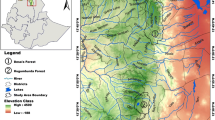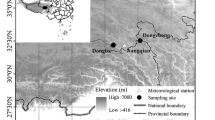Abstract
We investigated the characteristics and variability of radial growth patterns and the occurrence of growth releases in dominant trees in two old-growth forests in eastern Finland, one dominated by Picea abies and the other by Pinus sylvestris. The dominant trees exhibited high variation in radial growth patterns suggesting that the trees had experienced very different growing conditions and competitive situations during their lifespans. Based on visual evaluation, five types of radial growth patterns were distinguished: descending, even, unimodal (one peak in the growth rate), bimodal (two peaks in the growth rate with an intermediate depression) and fuzzy (no clear pattern). One or more growth releases were detected in 18% of the sampled Picea and in 21% of the Pinus trees. In both the Picea- and the Pinus-dominated sites, the temporal distribution of growth releases was relatively even, except for a moderate peak in 1855–1860. This suggests that small-scale disturbances have been the predominant disturbance mode in both sites during the last 150 years. We conclude that the detected variability in radial growth patterns likely reflects the overall small-scale heterogeneity of structure and developmental processes that are typical of old-growth forests.








Similar content being viewed by others
References
Aakala T, Kuuluvainen T (2010) Summer droughts depress radial growth of Picea abies in pristine taiga of the Arkhangelsk province, northwestern Russia. Dendrochronologia (in press)
Ahti T, Hämet-Ahti L, Jalas J (1968) Vegetation zones and their sections in northwestern Europe. Ann Bot Fenn 5:169–211
Angelstam P (1998) Maintaining and restoring biodiversity in European boreal forest by developing natural disturbance regimes. J Veg Sci 9:593–602
Bergeron Y, Leduc A, Harvey BD, Gauthier S (2002) Natural fire regime: a guide for sustainable management of the Canadian boreal forests. Silva Fenn 36:81–95
Busing RT (1996) Estimation of tree replacement patterns in an Appalachian Picea-Abies forest. J Veg Sci 7:685–694
Cajander AK (1926) The theory of forest types. Acta For Fenn 29:108
Edman M, Möller R, Ericson L (2006) Effects of enhanced growth on the decay capacities of three saprotrophic fungi. For Ecol Manag 232:12–18
Franklin JF, Spies TA, van Pelt R, Carey AB, Thornburgh DA, Rae Berg D, Lindenmayer DB, Harmon ME, Keeton WS, Shaw DC, Bible K, Chen J (2002) Disturbances and structural development of natural forest ecosystems with silvicultural implications, using Douglas-fir forests as an example. For Ecol Manag 155:399–423
Fraver S (2004) Spatial and temporal patterns of natural disturbance in old-growth forests of northern Maine, USA (Ph.D. thesis). University of Maine, Orono
Fraver S, White AS (2005) Identifying growth releases in dendrochronological studies of forest disturbance. Can J For Res 35:1648–1656
Frelich LE (2002) Forest dynamics and disturbance regimes. Cambridge University Press, Cambridge
Karjalainen L, Kuuluvainen T (2002) Amount and diversity of coarse woody debris within a boreal forest landscape dominated by Pinus sylvestris in Vienansalo wilderness, eastern Fennoscandia. Silva Fenn 36:147–167
Kuuluvainen T (1994) Gap disturbance, ground microtopography, and the regeneration dynamics of boreal coniferous forests in Finland: a review. Ann Zool Fenn 31:35–51
Kuuluvainen T (2002) Natural variability of forests as a reference for restoring and managing biological diversity in boreal Fennoscandia. Silva Fenn 36:97–125
Kuuluvainen T, Penttinen A, Leinonen K, Nygren M (1996) Statistical opportunities for comparing stand structural heterogeneity in managed and primeval forest: an example from spruce-dominated boreal forests in southern Finland. Silva Fenn 30:315–328
Kuuluvainen T, Mäki J, Karjalainen L, Lehtonen H (2002) Tree age distributions in old-growth forest sites Vienansalo wilderness, eastern Fennoscandia. Silva Fenn 36:169–184
Linder P, Elfving B, Zackrisson O (1997) Stand structure and successional trends in virgin boreal forest reserves in Sweden. For Ecol Manag 98:17–33
Näslund M (1942) Den gamla norrländska granskogens reaktionsförmåge efter genomhuggning. Meddelanden från Statens Skogsförsöksanstalt 33:1–212 (in Swedish)
Nowacki GJ, Abrams MD (1997) Radial-growth averaging criteria for reconstructing disturbance histories from pre-settlement-origin oaks. Ecol Monogr 67:225–249
Pham AT, De Grandpré L, Gauthier S, Bergeron Y (2004) Gap dynamics and replacement patterns in gaps of the northeastern boreal forest of Quebec. Can J For Res 34:353–364
Rouvinen S, Kuuluvainen T (2005) Spatial patterns of living trees in two areas with different fire histories in a boreal Pinus sylvestris forest in the Petkeljärvi National Park, eastern Fennoscandia. Community Ecol 6:1–12
Rouvinen S, Kuuluvainen T, Siitonen J (2002) Tree mortality in a Pinus sylvestris dominated boreal forest landscape in Vienansalo wilderness, eastern Fennoscandia. Silva Fenn 36:127–145
Vaartaja O (1951) On the recovery of released pine advance growth and its silvicultural importance. Acta For Fenn 58:1–133 (in Finnish with English summary)
Wallenius T, Kuuluvainen T, Heikkilä R, Lidholm T (2002) Spatial tree age structure and fire history in two old-growth forests in eastern Fennoscandia. Silva Fenn 36:185–199
Waring RH (1987) Characteristics of trees predisposed to die. Bioscience 37:569–574
Acknowledgments
We thank Tuomo H. Wallenius, Annikki Mäkelä and Shawn Fraver for help and advice in various stages of the study.
Author information
Authors and Affiliations
Corresponding author
About this article
Cite this article
Niukkanen, L., Kuuluvainen, T. Radial growth patterns of dominant trees in two old-growth forests in eastern Fennoscandia. J For Res 16, 228–236 (2011). https://doi.org/10.1007/s10310-011-0259-4
Received:
Accepted:
Published:
Issue Date:
DOI: https://doi.org/10.1007/s10310-011-0259-4




